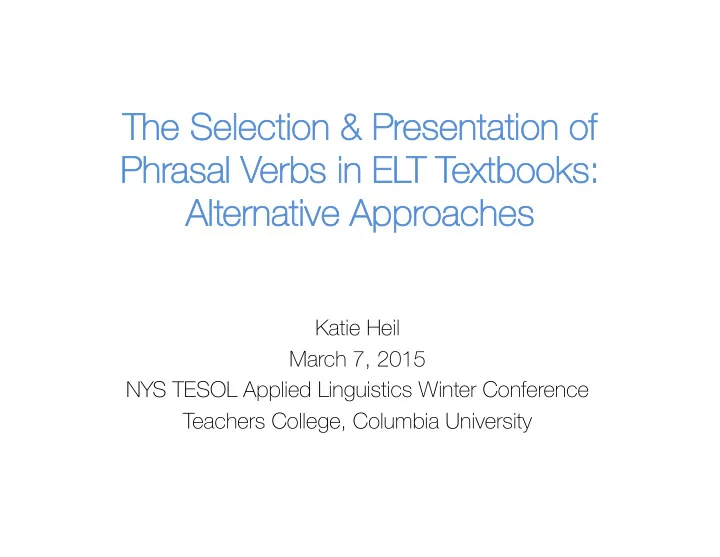

The The Sel Selecti ection n & Pres esentati entation n of Phrasal Verbs bs in ELT Textbo books: Alternative Appr pproaches Katie Heil March 7, 2015 NYS TESOL Applied Linguistics Winter Conference Teachers College, Columbia University
abide by abo bound d in accede to accord d with account for ace out ache for act act out out act up add up add up to adhere to agree with aim at allow for allow allow of of allude to allow for allow for allude to amount to angle for announce against announce for answer back answer answer for for answer to ante up arrive at arse around ascribe to ask ask aft after er ask around ask ask for for ask in ask out ask around aspire to associate with atone for attend to attest to attribute to auction off avail avail of of average out ba back away back down back into back off back onto back out back off back up bag up bail out ba bail up p bale out balance out ba balance up p balk at ball up balls up ba band d together bandage up bandy about bang about bang away at bang down ba bang into bang on bang out ba bang up p bank on bargain for bargain on barge into bark out base on bash about bash in bash up ba bask in bat around bat
PVs Vs and d Similar Syntactic Forms
Tr Transfer & Language Typology Verb- b-framed d language – motion, space, and temporality are expressed in the verb - Romance languages Satellite-framed d language – motion, space, temporality are expressed in the particle - Germanic languages trepar = climb up = ascend entre = go in = enter
Semanti Semantic c Nature of PVs Lit Liter eral al Semi-idi diomatic Metaph phorical Aspe pectual (Celce-Murcia & Larsen-Freeman, 1999) Iterative It ative – to show repetition e.g. she did it over again Incept ptive – to signal a beginning state � e.g. took off, or start up Compl pletive – to show a finished action � e.g. drink up, or burn down Co Conti ntinuati nuative ve – to show continuing action � e.g. carry on, danced away, goof around �
Co Cogni niti tive ve Linguistics Figures adapted from Evans, V. & Tyler, A. (2004a). Applying Cognitive Linguistics to pedagogical grammar: The case of over. In M. Archad & S. Neimier (Eds.), Cognitive linguistics, second language acquisition, and foreign language teaching (pp. 257-281). Berlin, Germany: Walter de Gruyter.
Resear Research ch Questions 1. How are PVs classified syntactically and to what extent are prepositional verbs conflated with inseparable PVs? � 2. How are PVs classified semantically and what, if any, attention is given to the contribution of the particle in assignment of meaning? � 3. Do the PVs explicitly taught in ELT textbooks reflect those most frequently used in English?
Methodo dology Selection of textbooks Coding of Activities Coding of PV types (literal, aspectual, idiomatic) Syntactic Tests Comparison to Corpus Data Gardner & Davies (2007) British National Corpus Liu (2011) Corpus of Contemporary American English (COCA) Longman Spoken and Written English (LSWE)
Sy Syntactic Trends Inseparable Phrasal Verb Lack of discussion of transitivity � Prepositional Verb Inseparable PVs are Prepositional Verbs: � run into, get over, take after, get through, look after, look into, pick on, drop by, get Intransitive off, head for � Phrasal Verb Syntactic rules split across texts
“If I tell somebody to bog off , that person is well aware that it has nothing to do with bogs and everything to do with beating a retreat. In other words, the main communicative function of the phrasal verb is carried by the particle.” � -Richard Side, 1990
Semanti Semantic c Groupings Same verb (4 texts) � Same particle (4 texts) � Literal vs. Idiomatic (4 texts)
Craven, M. (2013). Breakthrough Plus 4 . Oxford, England: MacMillan Education.
Saumell, M.V. & Birchley, S.L. English in Common 4 (2012). White Plains, NY: Pearson Education, Inc.
Soars, J., & Soars, L. American Headway 2. (2009). New York, NY: Oxford University Press.
Semanti Semantic Classification
Frequ quencies The top 100 PV forms found by Gardner & Davies constitute 51. 51.4% 4% of all instances of PVs in the BNC � The top 150 in Liu constitute 62. 62.95% 95% of all instances in the BNC, COCA, and LWSE � Textbo books Only 26 26 PVs Vs in (26% 26%) matched Gardner & Davies List Only 52 52 PVs Vs (36% 36%) matched Liu’s list
Co Concl nclus usions ns More frequ quent PVs should be integrated into ELT materials Materials emphasizing the contribu bution of the pa particle need further development Awareness should be raised about the syn syntac tactic tic stru structu tures s underlying PVs Emphasis should be placed on tr transi ansiti tivi vity ty of PVs rather than separability alone
Recommend
More recommend